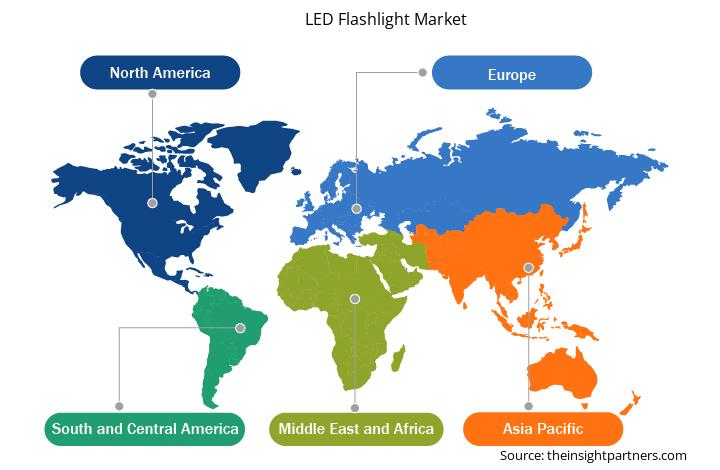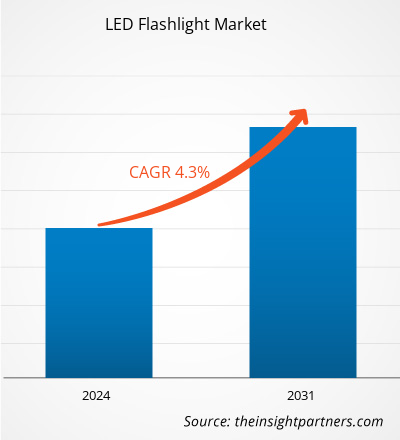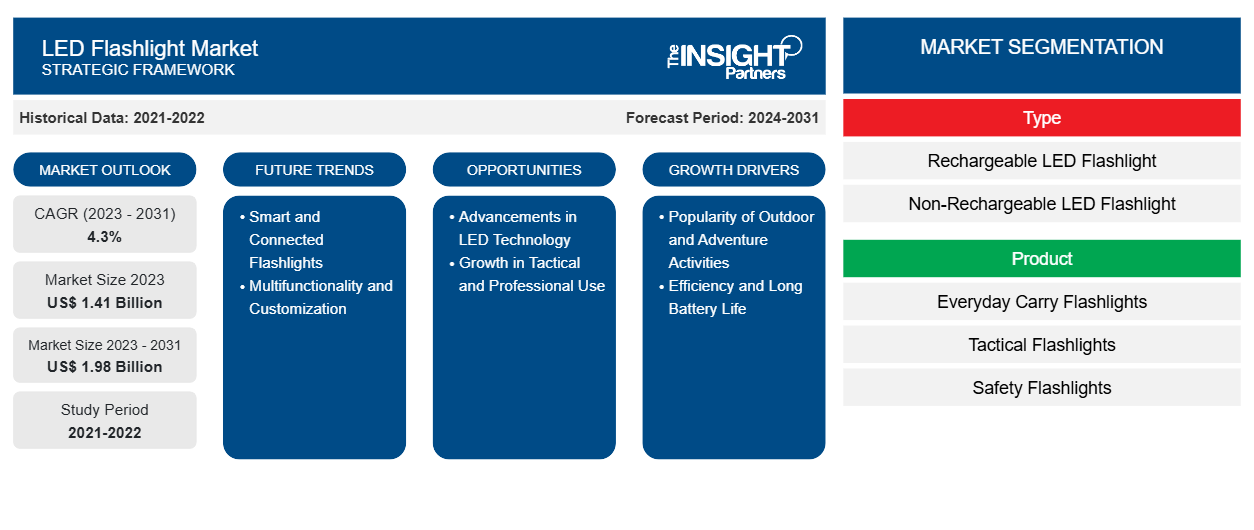Le marché des lampes de poche à LED devrait atteindre 1,98 milliard de dollars d'ici 2031, contre 1,41 milliard de dollars en 2023. Le marché devrait enregistrer un TCAC de 4,3 % au cours de la période 2023-2031. La demande croissante de lampes de poche intelligentes et connectées devrait apporter de nouvelles tendances sur le marché dans les années à venir.
Analyse du marché des lampes de poche à LED
La popularité croissante des activités de plein air et d'aventure ainsi que l'efficacité et la longue durée de vie de la batterie des lampes de poche LED stimulent la croissance du marché des lampes de poche LED . Alors que de plus en plus de personnes participent à des activités de plein air telles que le camping, la randonnée et la chasse, il existe un besoin croissant d'éclairage portable et fiable. De plus, les lampes de poche LED sont très économes en énergie, consomment moins d'énergie et ont une durée de vie de la batterie plus longue que les lampes à incandescence ou halogènes standard. En outre, les progrès de la technologie LED et la croissance de l'utilisation tactique et professionnelle devraient créer des opportunités lucratives pour la croissance du marché des lampes de poche LED. Les lampes de poche intelligentes et connectées ainsi que la multifonctionnalité et la personnalisation des lampes de poche LED devraient apporter de nouvelles tendances sur le marché des lampes de poche LED.
Aperçu du marché des lampes de poche à LED
Les lampes de poche à LED sont technologiquement avancées et peuvent répondre à bien plus que les simples besoins domestiques de base. Elles sont plus lumineuses, plus efficaces et plus fiables que les lampes de poche standard. Les lampes de poche à LED sont utilisées à diverses fins, notamment dans les situations d'urgence, les activités de plein air telles que le camping et la randonnée, les opérations militaires et policières, les inspections industrielles et le transport personnel quotidien. Elles sont essentielles pour la sécurité à domicile, l'entretien des voitures, la photographie, les examens médicaux et la recherche scientifique. Leur efficacité énergétique élevée, leur longévité et leur lumière intense et focalisée les rendent indispensables dans de nombreuses applications. Le marché des lampes de poche à LED bénéficie également de l'évolution vers des produits durables, car les lampes de poche à LED sont plus économes en énergie et durent plus longtemps que l'éclairage incandescent ou fluorescent traditionnel .
Personnalisez ce rapport en fonction de vos besoins
Vous bénéficierez d'une personnalisation gratuite de n'importe quel rapport, y compris de certaines parties de ce rapport, d'une analyse au niveau des pays, d'un pack de données Excel, ainsi que de superbes offres et réductions pour les start-ups et les universités.
-
Obtenez les principales tendances clés du marché de ce rapport.Cet échantillon GRATUIT comprendra une analyse de données, allant des tendances du marché aux estimations et prévisions.
Facteurs moteurs et opportunités du marché des lampes de poche à LED
Efficacité et longue durée de vie de la batterie
Les lampes de poche LED sont très économes en énergie ; elles consomment moins d'énergie et ont une durée de vie de la batterie plus longue que les lampes à incandescence ou halogènes standard. Les lampes de poche LED consomment moins d'énergie pour produire la même lumière, voire plus, ce qui en fait un choix privilégié pour les lampes de poche. Cela est particulièrement important pour les utilisateurs qui comptent sur les lampes de poche pour des activités de plein air, des urgences ou une utilisation professionnelle, où il est essentiel de maximiser la durée de vie de la batterie. Les lampes de poche LED deviennent de plus en plus populaires car les consommateurs et les entreprises apprécient la durabilité et les solutions rentables en raison de leurs coûts d'exploitation inférieurs et de leur impact environnemental réduit. Divers acteurs à travers le monde proposent des lampes de poche LED efficaces et offrant une longue durée de vie de la batterie. Par exemple, la communauté d'Anker propose la Bolder LC90 d'Anker, une lampe de poche LED à haut rendement et à faible coût conçue pour un usage quotidien. Elle a une autonomie allant jusqu'à 6 heures à haute luminosité (900 lumens) et peut être rechargée par USB-C, ce qui est une fonctionnalité pratique pour les utilisateurs actuels. De plus, la Fenix PD36R est une lampe de poche LED rechargeable très appréciée des amateurs de plein air, des randonneurs et des campeurs. Elle est alimentée par une batterie lithium-ion rechargeable 21700, qui peut durer jusqu'à 115 heures sur le réglage de luminosité le plus bas et 1,5 heure sur le réglage le plus élevé (1600 lumens). Une longue durée de vie de la batterie est essentielle en extérieur et en cas d'urgence, où l'accès aux sources d'alimentation est limité. Une lampe de poche, telle que la Fenix PD36R, permet aux utilisateurs de s'appuyer sur un seul appareil pendant de longues périodes, ce qui la rend parfaite pour les expéditions de plusieurs jours ou les scénarios d'urgence nécessitant un éclairage stable et fiable. Ainsi, l'efficacité et la longue durée de vie de la batterie des lampes de poche LED stimulent la croissance du marché.
Croissance de l'utilisation tactique et professionnelle
La demande de lampes de poche professionnelles et tactiques devrait augmenter dans des domaines tels que les forces de l'ordre, l'armée , la marine, la recherche et le sauvetage et la lutte contre les incendies. Ces industries ont besoin de torches hautes performances, durables et multifonctionnelles avec des caractéristiques telles qu'une luminosité élevée, une étanchéité et une durée de vie prolongée de la batterie. Les fabricants ont la possibilité de créer des torches spécialisées qui répondent aux besoins de ces professionnels. L'armée préfère les projecteurs tactiques qui peuvent être placés sur une arme ou une armure. Les lampes de poche militaires doivent être installées pour permettre une utilisation mains libres, car les armes portées nécessitent les deux mains. Divers acteurs proposent des lampes de poche LED pour une utilisation tactique et professionnelle. Par exemple, la lampe de poche Streamlight ProTac HL-X fournit jusqu'à 1 000 lumens de luminosité. Elle utilise des LED pour prolonger la durée de vie de la batterie, ce qui est essentiel pour les forces de l'ordre et le personnel militaire.
Le personnel de la Marine recommande d'utiliser une lampe de poche suffisamment puissante pour désamorcer les situations tendues. L'utilisation d'une lampe de poche à haute luminosité peut empêcher les spectateurs d'identifier et d'évaluer la personne qui porte la lampe. Empêcher la visibilité directe lors d'un combat avec des armes est une stratégie puissante qui peut être utilisée à la fois dans le civil et dans le militaire. De plus, en cas d'urgence, une lampe de poche tactique peut sauver des vies. La lumière vive peut être utilisée pour signaler une demande d'aide à longue distance. Si l'on est perdu dans les bois ou bloqué sur le bord de la route, une lampe de poche tactique avec mode stroboscopique ou SOS peut aider les sauveteurs à en trouver un plus rapidement. Certains modèles contiennent même des lentilles ou des filtres colorés qui peuvent être utilisés pour indiquer certaines formes d'inconfort. Ainsi, l'utilisation tactique et professionnelle accrue des lampes de poche LED devrait offrir des opportunités potentielles importantes pour le marché.
Analyse de segmentation du rapport sur le marché des lampes de poche à LED
Les segments clés qui ont contribué à l’élaboration de l’analyse du marché des lampes de poche à LED sont le type, le produit et l’application.
- En fonction du type, le marché est segmenté en lampe de poche LED rechargeable et lampe de poche LED non rechargeable. Le segment des lampes de poche LED rechargeables a dominé le marché en 2023.
- En fonction du produit, le marché est segmenté en lampe de poche de sécurité, lampe de poche de transport quotidien et lampe de poche tactique. Le segment des lampes de poche de transport quotidien a dominé le marché en 2023.
- En termes d'application, le marché des lampes de poche à LED est classé en résidentiel, commercial, militaire et forces de l'ordre. Le segment résidentiel a dominé le marché en 2023.
Analyse des parts de marché des lampes de poche à LED par zone géographique
- Le marché des lampes de poche à LED est segmenté en cinq grandes régions : l'Amérique du Nord, l'Europe, l'Asie-Pacifique (APAC), le Moyen-Orient et l'Afrique (MEA) et l'Amérique du Sud et centrale.
- L'Asie-Pacifique a dominé le marché des lampes de poche à LED, suivie de l'Europe et de l'Amérique du Nord. L'urbanisation rapide en Chine, en Inde et en Indonésie a augmenté la demande de solutions d'éclairage compactes, durables et économes en énergie. Dans les villes, les lampes de poche à LED sont utilisées non seulement pour la préparation aux situations d'urgence, mais aussi pour les activités nocturnes, telles que les déplacements domicile-travail et la sécurité personnelle. Les producteurs basés en Chine développent de nouvelles technologies LED qui offrent un rendement lumineux plus élevé, une durée de vie de la batterie plus longue et une durabilité accrue. Les progrès rapides de la technologie LED ont permis le développement de lampes de poche plus efficaces, plus fiables et plus économiques qui plaisent à un large éventail de consommateurs. Des entreprises basées en Chine telles que Xiaomi et Olight ont lancé des lampes de poche LED intelligentes avec des fonctionnalités telles que la luminosité réglable, le chargement USB et les options d'alimentation solaire. En outre, différents acteurs du marché collaborent pour développer des lampes de poche LED avancées. Par exemple, en collaboration avec Cree, IMALENT a apporté un nouveau niveau de luminosité et d'efficacité au domaine des lampes de poche. IMALENT et Cree LED ont indéniablement révolutionné le domaine des lampes de poche grâce à leur technologie de pointe et à leurs innovations révolutionnaires. Leur collaboration a inauguré une nouvelle ère de solutions d'éclairage ultra-lumineuses et fiables qui répondent à un large éventail d'applications, notamment les aventures en plein air, la préparation aux situations d'urgence ou l'utilisation professionnelle.
Aperçu régional du marché des lampes de poche à LED
Les tendances régionales et les facteurs influençant le marché des lampes de poche à LED tout au long de la période de prévision ont été expliqués en détail par les analystes d’Insight Partners. Cette section traite également des segments et de la géographie du marché des lampes de poche à LED en Amérique du Nord, en Europe, en Asie-Pacifique, au Moyen-Orient et en Afrique, ainsi qu’en Amérique du Sud et en Amérique centrale.

- Obtenez les données régionales spécifiques au marché des lampes de poche à LED
Portée du rapport sur le marché des lampes de poche à LED
| Attribut de rapport | Détails |
|---|---|
| Taille du marché en 2023 | 1,41 milliard de dollars américains |
| Taille du marché d'ici 2031 | 1,98 milliard de dollars américains |
| Taux de croissance annuel composé mondial (2023-2031) | 4,3% |
| Données historiques | 2021-2022 |
| Période de prévision | 2024-2031 |
| Segments couverts |
Par type
|
| Régions et pays couverts |
Amérique du Nord
|
| Leaders du marché et profils d'entreprises clés |
|
Densité des acteurs du marché des lampes de poche à LED : comprendre son impact sur la dynamique commerciale
Le marché des lampes de poche à LED connaît une croissance rapide, tirée par la demande croissante des utilisateurs finaux en raison de facteurs tels que l'évolution des préférences des consommateurs, les avancées technologiques et une plus grande sensibilisation aux avantages du produit. À mesure que la demande augmente, les entreprises élargissent leurs offres, innovent pour répondre aux besoins des consommateurs et capitalisent sur les tendances émergentes, ce qui alimente davantage la croissance du marché.
La densité des acteurs du marché fait référence à la répartition des entreprises ou des sociétés opérant sur un marché ou un secteur particulier. Elle indique le nombre de concurrents (acteurs du marché) présents sur un marché donné par rapport à sa taille ou à sa valeur marchande totale.
Les principales entreprises opérant sur le marché des lampes de poche à LED sont :
- Produits Bayco Inc.
- Produits de la côte
- Duracell Inc
- Brunissement
- Ledlenser GmbH & Co. KG
- Dorcy International, Inc.
Avis de non-responsabilité : les sociétés répertoriées ci-dessus ne sont pas classées dans un ordre particulier.

- Obtenez un aperçu des principaux acteurs du marché des lampes de poche à LED
Actualités et développements récents du marché des lampes de poche à LED
Le marché des lampes de poche à LED est évalué en collectant des données qualitatives et quantitatives après des recherches primaires et secondaires, qui comprennent d'importantes publications d'entreprise, des données d'association et des bases de données. Quelques-uns des développements sur le marché des lampes de poche à LED sont répertoriés ci-dessous :
- COAST, leader mondial de la technologie d'éclairage portable à LED et des couteaux, a lancé la lampe de poche SLAYER l'année dernière et a reçu des critiques exceptionnelles. Une lampe de poche élégante et fine, parfaite pour une utilisation quotidienne, dispose désormais d'options supplémentaires de mode lumière rouge ou d'un pointeur laser pour plus de facilité et de sécurité. La série de lampes de poche SLAYER est une construction étanche et résistante à la poussière avec des matériaux de première qualité adaptés aux travaux les plus difficiles. La forme rectangulaire plate du cadre tout en aluminium glisse facilement dans et hors des poches et se fixe en toute sécurité à l'aide du clip de poche en métal amovible. C'est un transport parfait en déplacement pour n'importe quel travail. (Source : COAST, communiqué de presse, marché 2024)
- Nite Ize, l'un des principaux fabricants de produits innovants basés sur des solutions, a lancé la lampe de poche tactique rechargeable à longue portée INOVA T4R. Disponible au détail à la fin de l'été, la lampe de poche montée sur berceau est dotée d'un faisceau impressionnant de 1 000 mètres pour briller lors de missions critiques et de conditions extrêmes. « La nouvelle lampe de poche à longue portée INOVA T4R est un véritable triomphe de l'ingénierie », a déclaré Rick Case, fondateur et PDG de Nite Ize. « Avec une portée efficace allant jusqu'à un kilomètre, elle est prête à être un outil essentiel pour les équipes de secours et au-delà. (Source : Nite Ize, communiqué de presse, juin 2023)
Rapport sur le marché des lampes de poche à LED et livrables
Le rapport « Taille et prévisions du marché des lampes de poche à LED (2021-2031) » fournit une analyse détaillée du marché couvrant les domaines mentionnés ci-dessous :
- Taille et prévisions du marché des lampes de poche à LED aux niveaux mondial, régional et national pour tous les segments de marché clés couverts par le champ d'application
- Tendances du marché des lampes de poche à LED, ainsi que la dynamique du marché, comme les facteurs moteurs, les contraintes et les opportunités clés
- Analyse PEST et SWOT détaillée
- Analyse du marché des lampes de poche à LED couvrant les principales tendances du marché, le cadre mondial et régional, les principaux acteurs, les réglementations et les développements récents du marché
- Analyse du paysage industriel et de la concurrence couvrant la concentration du marché, l'analyse de la carte thermique, les principaux acteurs et les développements récents pour le marché des lampes de poche à LED
- Profils d'entreprise détaillés
- Analyse historique (2 ans), année de base, prévision (7 ans) avec TCAC
- Analyse PEST et SWOT
- Taille du marché Valeur / Volume - Mondial, Régional, Pays
- Industrie et paysage concurrentiel
- Ensemble de données Excel
Rapports récents
Témoignages
Raison d'acheter
- Prise de décision éclairée
- Compréhension de la dynamique du marché
- Analyse concurrentielle
- Connaissances clients
- Prévisions de marché
- Atténuation des risques
- Planification stratégique
- Justification des investissements
- Identification des marchés émergents
- Amélioration des stratégies marketing
- Amélioration de l'efficacité opérationnelle
- Alignement sur les tendances réglementaires























 Obtenez un échantillon gratuit pour - Marché des lampes de poche à LED
Obtenez un échantillon gratuit pour - Marché des lampes de poche à LED